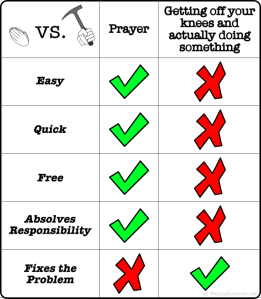Writing in a Scottish humanist magazine, blogger Friendly Humanist recounts an experience with Mormon missionaries seeking to convert him. FH gave them a fair hearing and even allowed them to conduct an “experiment they asked us to try after our first meeting.”
They asked us to pray.
I found myself facing a dilemma. On the one hand, praying feels like a betrayal of my values as a humanist. How could I sincerely ask for an answer from a god whose existence I believe to be improbable, undiscoverable, and irrelevant to living a good life? On the other hand, free thinking is at the heart of humanism. Prayer is an experience I had never tried before
FH tried the prayer. It’s a common Mormon tactic to ask people to pray until they feel the “stirrings of the Holy Spirit” or “God’s Voice” which is supposed to affirm whatever the missionary has explained about their faith (in short, Mormonism is divinely inspired by a known charlatan who “saw” ancient writings on a golden plate hidden in his hat).
FH recounts: “Nothing that could be interpreted as a message from a god – not even a little thrill of what-if. Later, I related this experience to the Mormons. They were undeterred. They encouraged me to keep trying: “God is not always heard the first time.”
As they are trained to do, the missionaries kept pushing, unperturbed:
[O]ne of the Mormons promised, “If you keep trying, eventually you will get an answer.”
FH countered with this:
Well, I have tried the experiment. I have set aside my reservations and sought the truth, true to my humanist values. And I have an answer. There probably is no personal god.
The reason the Mormons use this technique (pray until you feel something) is based on the idea (and my brain science is a little fuzzy here but I think I have the general idea) that the human brain will fill in the blanks if given an “assignment” absent any other stimulus (like “Brain, locate the voice of God”).
We have evolved as creatures who use our intricate brains to fill in any gaps in our understanding almost automatically. When we were hunter-gatherers and competing with other predators, it was to our advantage that our minds looked for patterns in the wilderness and could quickly interpret a blurry image as a possible killer and experiences often confirmed these patterns. It’s no surprised that, if we asked to not think of the pink elephant or asked to look for a divine presence, our pattern-seeking apparatus immediately goes into hunt-and-seek mode — elephants appear unbidden and divine flashes spark across our synapses.
Someone who is not as philosophically aware as the Friendly Humanist is bound to eventually feel a presence of hear a voice given all the positive reinforcements by the missionaries. From a technical standpoint, the Mormons have developed a pretty smooth tactic.
The reason the Mormons use this technique is based on the idea (and my brain science is a little fuzzy here but I think I have the general idea) that the human brain will fill in the blanks if given an “assignment” absent any other stimulus (like “Brain, locate the voice of God”).
We have evolved as creatures who use our intricate brains to fill in any gaps in our understanding almost automatically. Traditional Easter philosophers have called this the “monkey mind” functioning of the brain.
I found it fascinating that Friendly Humanist used an almost Zen technique during his prayer experiment —not actively seeking, just keeping his rational mind and his monkey mind still.
I sat in a comfortable posture in a quiet room, closed my eyes, and asked aloud, “God, do you exist?” I quieted my thoughts to make room for even the softest suggestion from an external deity.
Although I’m not a skilled meditator, I have found that, when I take time to keep my mind still, I’m much less tempted to behave in an irrational manner. For those who pray without some skepticism, it seems as if they already, Fox-Mulder-like, want to believe.
Someone who is not as philosophically aware as Friendly Humanist is bound to eventually feel a presence or hear a voice given all the positive reinforcement offered by the missionaries. From a technical standpoint, the Mormons have developed a pretty smooth tactic.
For a copy of a Mormon missionary handout revealed by an ex-Mormon, click here.




 Posted by Mountain Humanist
Posted by Mountain Humanist 

